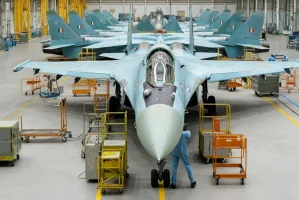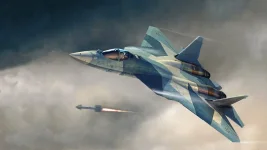- Views: 2K
- Replies: 12
Amid reports of Pakistan potentially inducting two squadrons of China's fifth-generation J-35 fighter jets by the close of 2025, a former high-ranking Indian Air Force official has suggested a strategic procurement to address the evolving air power landscape in the region.
Air Marshal Sanjeev Kapoor (Retd.) has put forward the acquisition of Russia’s Su-57E stealth fighter as an interim measure until India’s indigenous Advanced Medium Combat Aircraft (AMCA) is ready for operational service.
Air Marshal Kapoor conveyed his views on the social media platform X, stating, "With reports of Pakistan acquiring two squadrons of J-35s from China by year-end, procuring 2 to 3 squadrons of Su-57E from Russia could be an interim option for us bridging the gap until AMCA is operational."
He emphasized the critical need for India to maintain its technological advantage in aerial combat capabilities within the region.
The J-35, also known as the FC-31 Gyrfalcon, represents China's latest foray into fifth-generation stealth fighter technology and is positioned as a competitor to advanced aircraft like the American F-35.
While the J-35 is still in development, it is anticipated to possess low-observable (stealth) characteristics, sophisticated avionics, and the versatility for multiple combat roles.
The acquisition of an estimated 24 to 36 J-35 aircraft by the Pakistan Air Force (PAF), assuming standard squadron strengths, would significantly bolster Pakistan's air combat strength, potentially challenging India's current air superiority.
There is also ongoing development of a naval variant of the J-35, indicating China's broader ambitions for this aircraft platform.
Pakistan's deepening defence collaboration with China, highlighted by its existing fleet of JF-17 Thunder jets (a joint Sino-Pakistani development) and other Chinese-origin military systems, makes the potential J-35 acquisition a logical progression in its air force modernization efforts.
However, some analysts have raised questions regarding the feasibility of inducting these advanced jets by the end of 2025, considering the J-35's current developmental stage and typical production and integration timelines for such complex weapon systems.
To counter this emerging capability, Air Marshal Kapoor has proposed the procurement of approximately two to three squadrons (roughly 36 to 54 aircraft) of Russia’s Su-57E.
The Su-57E is the export version of the Su-57, NATO reporting name "Felon," which is Russia’s first operational fifth-generation stealth fighter. This aircraft features advanced radar systems, the ability to sustain supersonic flight without afterburners (supercruise), and a comprehensive suite of weaponry.
While the extent of its stealth capabilities compared to Western counterparts like the F-22 or F-35 is a subject of ongoing discussion among defence analysts, the Su-57E is considered a mature and formidable platform that could potentially be integrated into the IAF relatively quickly.
India's long-standing defence relationship with Russia, which includes the operation and licensed manufacturing of Su-30 MKI jets, makes the Su-57E a plausible interim option.
Air Marshal Kapoor’s suggestion appears to stem from concerns about the development timeline for the AMCA. This indigenous fifth-generation fighter, currently being developed by India's Aeronautical Development Agency (ADA) and Defence Research and Development Organisation (DRDO), is still in its design and early development phases.
Initial projections suggest the AMCA is unlikely to enter active service before the mid-2030s, potentially leaving a capability gap in the intervening years.
The introduction of J-35 fighters into the Pakistan Air Force could significantly alter the aerial military balance in South Asia, especially given the persistent geopolitical tensions between India and Pakistan.
India currently operates a diverse fleet of capable fourth-generation fighters, including the French Rafale, the Russian Su-30 MKI, and the upgraded MiG-29.
While formidable, these aircraft generally lack the advanced stealth, sensor fusion, and networked operational capabilities inherent in fifth-generation platforms.
The Su-57E, despite any criticisms, could offer India a near-term fifth-generation capability to effectively counter the J-35 and maintain a credible deterrent.
However, the path to acquiring the Su-57E is not without potential obstacles. India had previously been a partner in a joint programme with Russia to develop a fifth-generation fighter based on the Su-57, known as the Fifth Generation Fighter Aircraft (FGFA) project, but withdrew in 2018 citing concerns over the aircraft's stealth technology, overall cost, and the extent of technology transfer.
Furthermore, India's strengthening strategic and defence partnerships with the United States and other Western nations could complicate a major defence acquisition from Russia, particularly in light of potential US sanctions under the Countering America's Adversaries Through Sanctions Act (CAATSA).
The AMCA remains India's definitive long-term solution for a domestically produced fifth-generation fighter. This ambitious project aims to deliver an aircraft equipped with advanced stealth features, supercruise capability, cutting-edge avionics, and artificial intelligence-driven systems, thereby significantly reducing India’s dependence on foreign military hardware.
Nevertheless, with the first prototypes of the AMCA still some years away from their maiden flights and full operational capability likely more than a decade off, considering interim measures such as the Su-57E could be crucial for ensuring the Indian Air Force maintains its competitive edge and addresses any immediate capability shortfalls.



